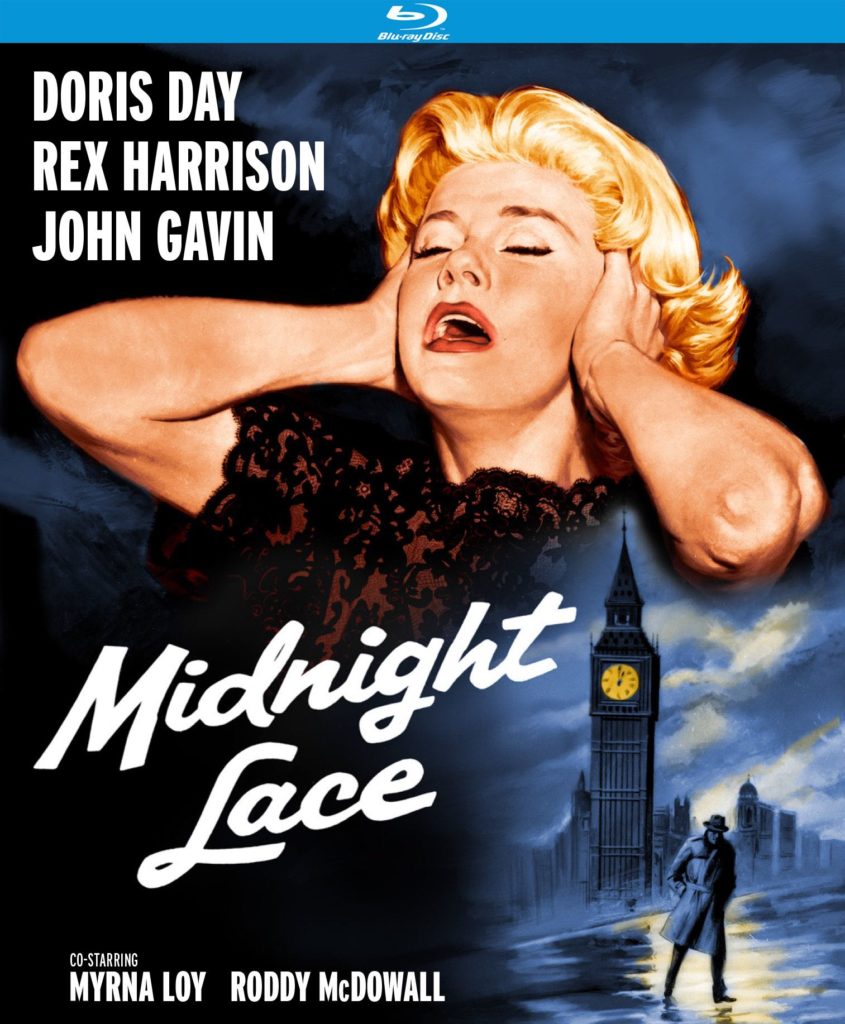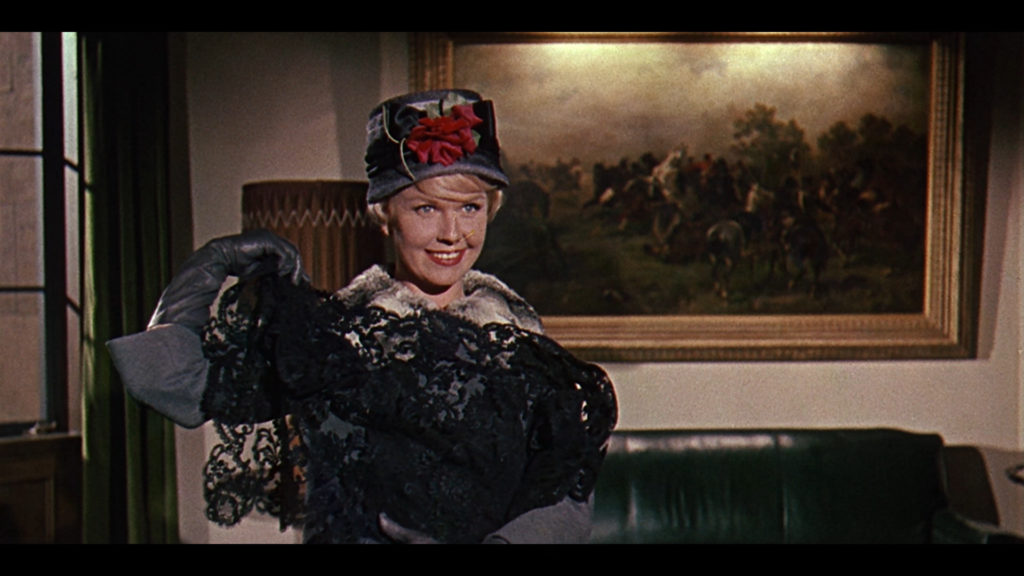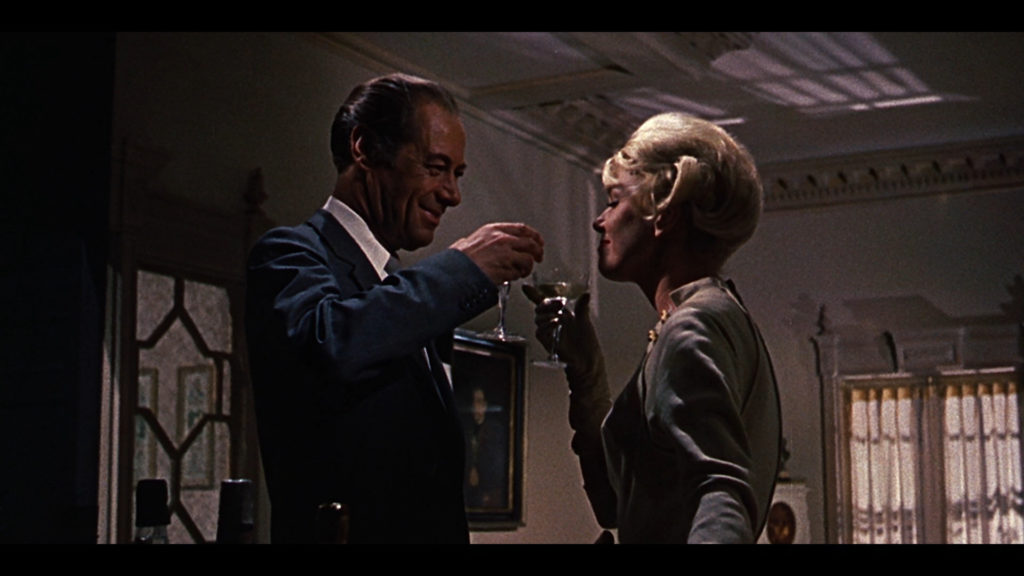Doris Day And Where the Suspense Film Met The Women’s Picture
1960/DIRECTED BY DAVID MILLER
STREET DATE: JUNE 25TH, 2019/KINO LORBER STUDIO CLASSICS

From its London-recreated prologue and opening credits scene, a Universal soundstage studio-dressed as fog-shrouded Grosvenor Square, glamorous Doris Day, immaculately coiffured and stylishly dressed, is menaced by a high-pitched, disembodied voice sounding as if it should be coming through the clacking wooden lips of a creepy ventriloquist’s dummy. Through persistent phone calls into the next weeks, laughed off by her practical businessman husband as a “peasouper prank”, the selective tin-echoes we hear of similar mortal threats — escalating to unheard profanity and “pure filth” — come to involve Scotland Yard, whose chief inspector initially questions the legitimacy of the phone calls, and by extension the very existence of the phone caller him(it?)self. As odd characters and suspicious motivations mount and multiply — including the wastrel son of the couple’s housekeeper, a business rival wiped out in shady dealings, a business ally drowning in debt, a handsome young war veteran suffering from memory blackouts, a trenchcoat-clad stranger lurking in the street shadows — so too do the persecuted wife’s friends and relations — her female friend next door, her visiting aunt, even her own husband — begin to doubt, at least from her (and our) increasingly fraught perspective, the reality of the piping phantom voice posing harm and murder in frankly unimaginable terms. But nearly two-thirds through 1960’s Midnight Lace we are precisely in the same emotional position as Doris Day’s Kit Preston: we too have heard that puppet-like voice and are as equally aware of what it is capable.
That tightly restricted and unusually involved point of view, possibly melodramatically conveyed above, is nevertheless in effective keeping with the cross-section of genres upon which Midnight Lace skillfully intersects. Thriller, soap opera, potboiler, even horror movie; faintly ridiculous that the threat to life, honor, and dignity of a cartoon-like voice screeching obscenities through a foggy park or over the clicking exchange of a telephone wire might look in print, actually hearing such and visually registering the indifference of other characters to the evidence of the central character’s experience — and by extension the audience which strongly identifies with her — is an undeniably stressful, nightmarishly surreal position to place a sympathetic protagonist. Throughout Midnight Lace, the film-length suspense over a woman’s fear and trauma, while the woman in question is not being taken seriously, creates an almost palpable sense of anxiety in the viewer. We may not have all encountered first-hand such a dismissive attitude from those close to us, such as when a husband wonders aloud whether he is “married to a child” — essentially blaming the victim for the circumstance of her own victimization — but that mental anguish is very acute here beneath Midnight Lace’s surface layers of designer outfits and tastefully appointed interior decorations.

Artistically merging the dramatic and stylistic worlds of Alfred Hitchcock and Douglas Sirk, producer Ross Hunter — who produced many of Sirk’s better-known works at Universal-International, including Magnificent Obsession (1954) and All That Heaven Allows (1955) — assembled a strong cast steeped in classic Hollywood associations, many of whom held equally strong associations with the Master of Suspense himself. With the always delightful Myrna Loy as Day’s aunt and Roddy McDowall extremely effective in the small but memorable role of a suave yet slimy mercenary, direct cast links to the Hitchcock filmography include the charming yet vaguely uneasy Herbert Marshall (Murder! [1930], Foreign Correspondent [1940]), a doubting Scotland Yard inspector as played with mustachioed authority by British supporting actor John Williams (Dial M for Murder [1954], To Catch a Thief [1955]), and an additionally smaller but also crucially cast figure of sinister import enacted by the cadaverous Anthony Dawson (DMfM).
Strongly evoking classical models of the terrorized female in such inescapable fare of the 1940s as George Cukor’s Gaslight (1944) and especially Anatole Litvak’s Sorry, Wrong Number (1948), the spoiler levels and red herring reversals this review is withholding — commencing from the film’s shocking third act — receive an effective boost by what one might term the film’s “fulcrum figure”, courtesy of John Gavin’s outer-strength but inner-damaged building contractor Brian Younger. The actor, previously established as a stalwart romantic figure in Sirk and Hunter’s classic Imitation of Life (1959), opposite Lana Turner, had but one month before the release of Midnight Lace appeared to similarly ambivalent effect as philanderer-turned-investigator Sam Loomis in Alfred Hitchcock’s Psycho (1960).

But it is with Midnight Lace’s two leads that the film becomes most powerful as both melodrama and shocker, Rex Harrison’s London-based businessman Anthony Preston appearing quick, magnetic, and easy-going, at least on the surface, opposite Doris Day’s wealthy and stylish Kit Preston. As an elegant married couple to be envied by its midcentury audience, the Russell Metty photography — casting multi-hued lighting against its Eastmancolor stock in at times visually hallucinatory terms, approaching the cinematographer’s mid-1960s apotheosis of blazing Technicolor for his and Hunter’s future Madame X (1966) — lingers over the expressive detail of the Preston’s luxury flat with a fetish eye belied by low-key shadows and at times almost noir-soaked compositions. As conflict and doubt enters its crisis phase for the Prestons, signaled by the deepening visual style of its telling, the entirely reasonable presence of Rex Harrison and the preternaturally poised figure of Doris Day begin to narratively, thematically, and visually unravel due entirely to the untoward intrusion — both real and imagined — of that comic-sounding but decidedly unfunny-in-effect VOICE of fear and uncertainty.
Star Doris Day dominates Midnight Lace from her terrorized fogwalk through a London Peasouper to the final nighttime closeup on her mascara-smeared features. Building emotionally off her dramatic co-starring role in Alfred Hitchcock’s 1956 remake of The Man Who Knew Too Much, where screen everyman Jimmy Stewart, as her doctor-husband, forcefeeds Day as his hysterical wife a handful of sedatives, Day’s Kit Preston struggles to be taken seriously while yet another telephone call harrowingly looms, every sudden ring from the room’s oppressive silence successively building to the psychological crisis depicted on the film’s poster (and on Kino Lorber’s Blu-ray cover). As revealed in Kat Ellinger’s informative commentary accompanying the Blu-ray, the considerable stress of the role — and more directly in filming that scene — caused a real-life breakdown for the actress, past associations with a former abusive husband proving too much in playing this role. And although Doris Day would never attempt a dramatic role of this nature again, the screen evidence of Midnight Lace against the actress’s always assured work in musicals like The Pajama Game (1957) and romantic comedies like Pillow Talk (1959) testify to the depth and range of her talent. Joining the glamor of her persona with the darker (and easily overlooked) edges of her personality, Doris Day proved a brilliant choice for Midnight Lace-embodying the emotional point where the suspense film and the women’s picture artistically meet.
As mentioned, Kino Lorber’s Blu-ray includes an always welcome Kat Ellinger commentary track, the writer and film historian offering her usual level of insight into Midnight Lace’s production details along with its historical and artistic context. Drawing connections to the subsequently emerging genre tropes of the Italian Giallo film — Midnight Lace’s suspenseful use of the telephone and the revelations and red herrings of the black-gloved killer proving particularly influential — along with unravelling the thematic threads of sexuality, repression, and marital discord, Ellinger successfully argues Midnight Lace’s intersection between noir and romance, shock and sheen. Available for viewing in both a 1.78:1 and the more unusual 2.01:1 aspect ratio, one imagines Midnight Lace may benefit from the choice of its viewing — either as a claustrophobic thriller or as an expansive soaper — but ultimately satisfies whichever way one looks at it.
The images used in this review are credited to DVDBeaver but do not reflect the image quality of Kino Lorber’s Blu-ray as they are taken from an earlier Blu-ray release. They are used solely as visual reference to the film. Special thanks to Kino Lorber for providing a review copy.

